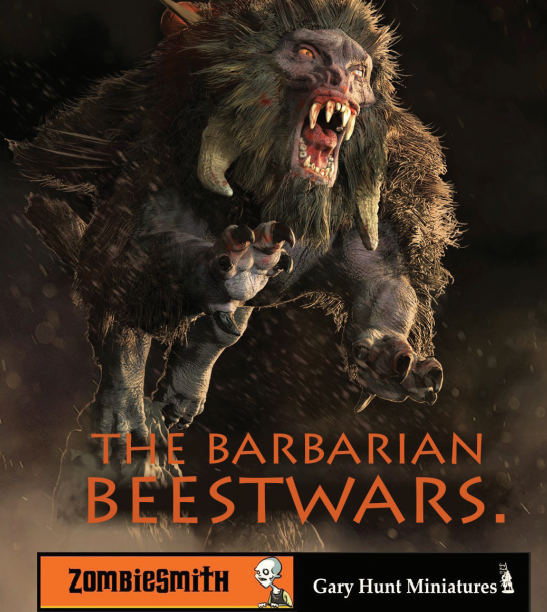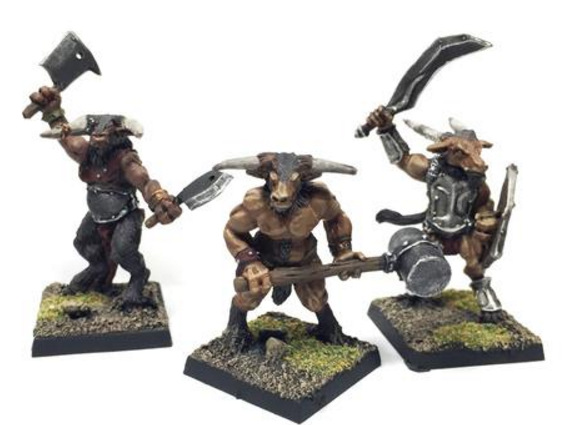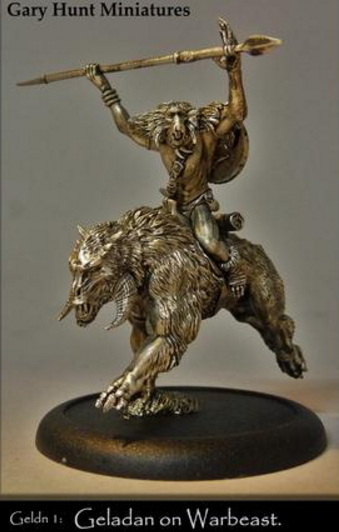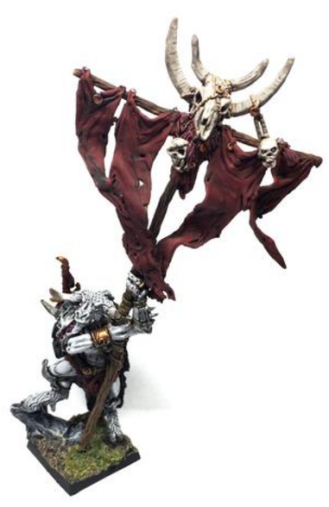Staying true the Voraciousness of Voracious Gamer I was browsing the news sites as I do and stumbled across a quickstart rules .pdf released for a game I’ve never heard of which lead me to Zombiesmth’s website and Gary Hunt’s Miniature line who combined sometime back in 2015. Utilizing the line to make a miniatures game seems to be the next step mini companies take. I can dig that, so let’s dive in to The Barbarian Beestwars to see what’s up. As always I’ll ramble my way through for your reading pleasure. The quickstart has a bit of fluff that we might as well cover because beasts are fluffy right, these ‘Beests’ are fluffy and fierce.

There are two factions or so it seems, The Clovis and The Geladan. The Clovis were once a mighty horde that had to be kept at bay by the combined races of the world. Fearsome beasts and minotaurs that live and die for war and slaughter acting as a force of general entropy for the lands of ‘not-certain-what-the-world-is-called’. But they were defeated in one great battle that sent them licking their wounds to the farthest reaches where they became myth and tales to scare young ones. Secretly reforming and rebuilding they were content with being the stuff of nightmare for some time. That time of relative peace was still punctuated by sightings but The Clovis didn’t appear en masse until recently. In hindsight the civilized folks should have followed them to their holes to exterminate them completely because they’re back with a bone (probably femur) to pick and with them comes war.
The Geladan are not the aforementioned civilized folk in fact they’re the polar opposite. Basically the living examples of the missing link between human and primate. They hail from the simian mountains and are regarded as savages by most. But The Geladan are peaceful when they can be and live in large family groups. Some even trade with the human, dwarf and elf populations to maintain their society. When they are threatened though the Galadan pull out all the stops. Some Geladan have begun breaking from their tribes and adventuring across the lands as mercenaries. It’s still unclear whether they are outcasts or criminals or some attempt to reach out and become bigger players on the world scale.

An example stat block is pictured above for the Clovis Satyr let’s run through it and name him Bob. Sk is skill, this is the fighters ability to do things and stuff. The higher skill the better, skill tests are for combat and other in game purposes. Might is represented by Mt and represents the amount of damage dealt in combat, Satyr Bob does 2d6 damage. Toughness with a T is next, this represents the armor, strength or even stupidity of the fighter. Ma stands for Movement Allowance and it represents the number of inches a fighter can.. You guessed it, move! Equipment is self-explanatory as well, Satyr Bob has a spear. Oh, I skipped D which is for defense but that’s okay because Satyr Bob has none. The defense is used to represent armor or supernatural endurance. Next are the abilities, like many modern wargames models have special actions or traits to make them unique, some are always on type abilities while other require a skill check. On the far right hand side we’ve got the points cost per Satyr, games are recommended to range from 200 to 500 points.
Skill Checks are up next. To perform them you roll 3d6 and compare the value to the Skill being tested. IF the result is equal to or under the Sk then it’s a success. Some skill checks have benefits for rolling low and/or consequences for rolling high. A fighter in the game can be in the four different states. Ready means the fighter is ready to take an action and unengaged. Engaged means the fighter is base to base with an enemy, the game does have facing so models can be in-front or behind their foes. The third status is discombobulated, which means the fighter is suffering that prevents it from taking actions. Discombobulated fighters can only do one thing which is to seek ‘recombobulation'( I may have made that word up) or a Ready status once again. The last status is Killed.

There is an in-game resource called Froth, it wouldn’t be Beestwars if something wasn’t frothing after all. Froth is used to perform special actions and occasionally bend the rules of the game. It looks like Froth can be used to increase attributes temporarily and even to declare charge attacks. Each commander (player) begins the game with five froth and gains +1 F for killing an enemy fighter and +2F for killing an enemy hero.
When playing Beestwars players use an activation deck to decide the number of actions they get per round. The deck is nine cards in total, three sets of three numbered 3, 4 and 5. This means commanders (players) always have at least three actions per round but could get more if luck is on their side. Now here’s some intriguing mechanics, you draw the card for your opponent! You don’t show them which you drew for them, after their third action they ask you if they have a fourth action and then a fifth. When they’ve taken the number of actions you drew for them reveal the card and play shifts so they draw a card for you. A nifty rule and process indeed!, evoking a sort of fog of war\unpredictability variable in commanding your forces.
The active player may assign up to two actions to each fighter, one may be used for combat actions. Players can assign these one by one, waiting to see the results of each before assigning the next. They may also jump around from fighter to fighter and back. Perhaps using some kind of counter or bead to represent an action next to the fighter on the table may be wise. Each turn has repeating rounds until the action deck is exhausted which signals the end of the turn.

Actions are broken down to Move, Sprint and Disengage. Move means Satyr Bob can move 4 inches, if he ends in base contact then his status changes to engaged. Sprint actions allow the fighter to move double their M value but they may not get within two inches of an enemy when doing so nor may they end in base to base contact with an enemy. If a fighter chooses to Sprint they cannot perform a second action. Disengage
requires the fighter to make a skill check to move out of base contact with an enemy. Failing a disengage means the enemy fighter gets a free attack. The skill check to disengage is at -1 for each enemy in base to base beyond the first.
Combat actions are more varied than traditional melee\ranged. You spend an action to declare an attack then roll against your fighters skill. Certain numbers mean certain things (shown below) happen regardless of the result. There are a few modifiers to the attacking fighters skill, they get +2 for discombobulation and 0 to -3 if the target has any defense. If the target is outnumbered they get +1 per ally engaged with the target. Once a hit occurs the attacking fighter makes a might roll and compares it to the targets Toughness. Equal to or greater means it’s discombobulated and double the toughness means the target is killed!

There are a few special attack actions outlined in the quickstart as well like Shieldbash, Powerful Blow, Charge, Ranged Attack, Aimed Shot and On Guard leading to some interesting interactions on the table. We’ll detail those as necessary or perhaps in a later blog post. Suffice it to say I’m intrigued by the options here and interested to see how it all plays out.
Discombobulated is no status to be in, fighters in this status must make a skill check to recover using the following chart.

Up next are the details on the special abilities like Satyr Bob’s Reach and Bodyguard of which there are twelve defined. We’ll leave those details to a second post, download the rules and have a look for yourself. Some of the others are Wallop, Counterattack, Cavalry, Dead-eye and Skirmisher.

As I mentioned earlier beginners should play two hundred points and veterans should be in the four to five hundred range. Named characters are unique and can only be taken once. Satyr Bob is only a rank and file Satyr after all so we’d be free to take Satyr Jill, Satyr Marcus and Satyr Fluffyminkboppinstuffs if we want to that is. The game plays out on 2×2 board (sweet!) I don’t know what it is having started my gaming on a 6×4 back in the day I enjoy getting in close for skirmishes. Terrain should be fair, no hard minimums but we all know terrain can make the story and game interesting so shoot for 1/3 to 1/4 of the table being terrain. Deployment zones are opposite board edges each four inches out. The player who placed the terrain lets his opponent decide which board edge they want. (One note on miniature basing, I’m assuming the typical 30,40, 50mm round bases are used for the game. A few of the pics are on squares but the models were made before the game.)
Deployment is done one fighter at a time, alternating between commanders. After that each player rolls a d6 and the highest decides to go first or second. Then each player takes their five froth counters and the game begins with the active players opponent drawing their action card. On each turn after the first a d6 should be rolled to decide who goes first once again. The battle wages on until one side is completely eliminated or the players can agree on who won the encounter.
At the tail end of the quickstart rules there are fighter profiles for each faction and an ‘activation deck’ that can be printed and cut for the players. I do want to give this game a try, not certain if finances will allow me to do so with Gary Hunt’s miniatures but we’ll see. In the next post on Beestwars I’ll make a 200 point list for each faction and\or the two recently announced faction starter boxes and go into some of the special abilities. Get your beesty self over to twitter and follow me @vorgames for gaming goodness and musings on the industry and do check out the Zombiesmith range and site.
As always be wary of minotaurs and happy gaming!
[…] Learnin’ Beestwars Part 1 Quickstart rules […]
LikeLike